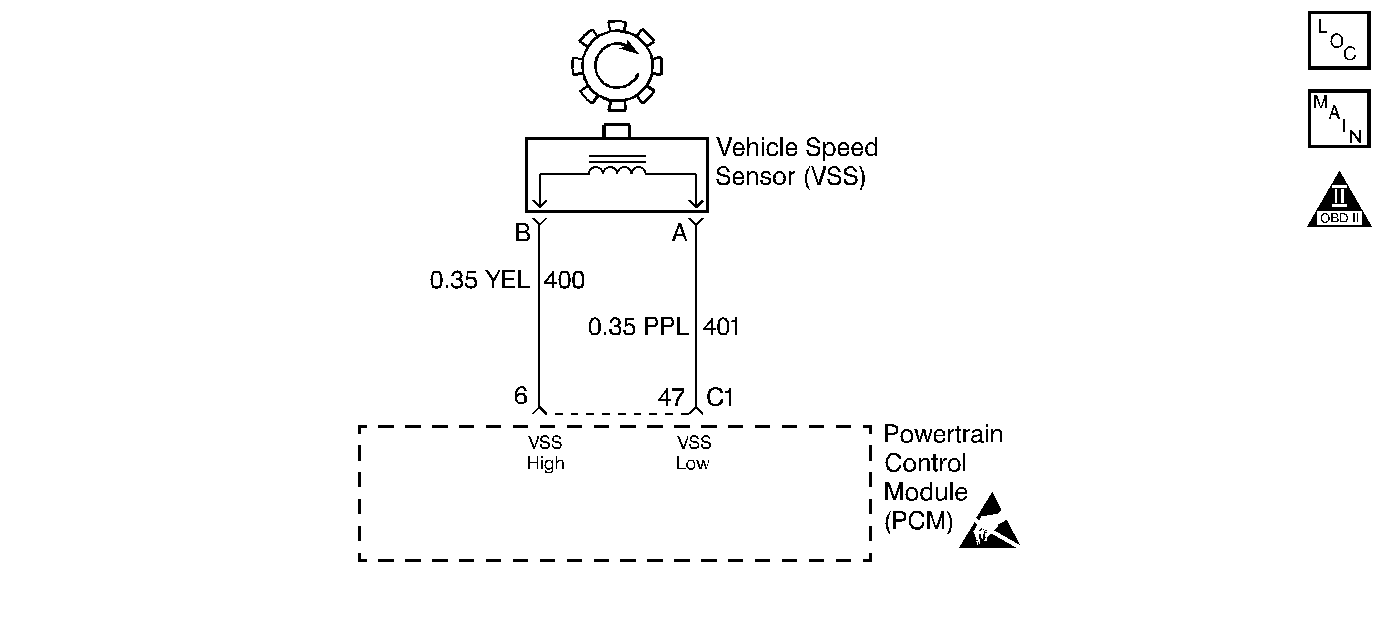DTC P0503 Vehicle Speed Sensor (VSS) Circuit Intermittent 3.8L, VIN K Only

Circuit Description
The Vehicle Speed Sensor (VSS) provides vehicle speed information to the Powertrain Control Module (PCM). The VSS is a Permanent Magnet (PM) motor. The VSS produces a pulsing AC voltage. The AC voltage level and the number of pulses increase as the speed of the vehicle increases. The PCM converts the voltage pulses to vehicle speed. A scan tool can display the calculated vehicle speed.
If the PCM detects an unrealistically large drop in the output speed in two consecutive ignition cycles, then DTC P0503 sets. DTC P0503 is a type B DTC.
Conditions for Setting the DTC
DTC P0503 sets if the following conditions occur once per ignition cycle, two consecutive times.
| • | No TFP Manual Valve Position Switch DTC P1810. |
| • | The engine speed is greater than 400 RPM for five seconds and not in fuel cutoff. |
| • | The time since the last gear range change is greater than six seconds. |
| • | The transmission output speed does not rise by 500 RPM within six seconds. |
| • | The transmission output speed drops by greater than 1600 RPM in Park/Neutral. |
| • | The transmission output speed drops by greater than 1300 RPM and is not in Park/Neutral. |
| • | All conditions are met for 3 seconds. |
Action Taken When the DTC Sets
| • | The PCM commands a soft landing to second gear. |
| • | The PCM inhibits TCC engagement. |
| • | The PCM commands maximum line pressure. |
| • | The PCM inhibits fourth gear in Hot Mode. |
| • | The PCM freezes shift adapts from being updated. |
| • | The PCM illuminates the Malfunction Indicator Lamp (MIL). |
Conditions for Clearing the MIL/DTC
| • | The PCM turns OFF the MIL after three consecutive ignition cycles without a failure reported. |
| • | A scan tool can clear the DTC from the PCM history. The PCM clears the DTC from the PCM history if the vehicle completes 40 warm-up cycles without a failure reported. |
| • | The PCM cancels the DTC default actions when the fault no longer exists and the ignition is OFF long enough in order to power down the PCM. |
Diagnostic Aids
| • | An incorrect VSS calibration may set DTC P0503. Refer to Service Bulletins to ensure that the calibration is the most current. |
| • | When diagnosing for an intermittent short or open, massage the wiring harness while watching the test equipment for a change. |
| • | Inspect the wiring for poor electrical connections at the PCM. |
| • | Inspect the wiring for poor electrical connections at the transmission 20-way connector. Look for the following problems: |
| - | A bent terminal |
| - | A backed out terminal |
| - | A damaged terminal |
| - | Poor terminal tension |
| - | A chafed wire |
| - | A broken wire inside the insulation |
| • | Test circuits 400 and 401 for Electromagnetic Interferences (EMI) induced by a wiring harness incorrectly routed near the spark plug wires. |
| • | Inspect for a damaged VSS. |
| • | Inspect for damaged transmission rotor teeth. |
| • | Ensure that the VSS is correctly aligned and torqued securely to the transmission case. |
Test Description
An example test description follows:
-
This step verifies the integrity of the VSS.
-
This step tests the resistance of the VSS.
-
This step verifies the integrity of the VSS circuit.
Step | Action | Value(s) | Yes | No | ||||||||||||
|---|---|---|---|---|---|---|---|---|---|---|---|---|---|---|---|---|
1 | Was the Powertrain On-Board Diagnostic (OBD) System Check performed? | Go to Powertrain On Board Diagnostic (OBD) System Check , Section 6. | ||||||||||||||
2 |
Important: Before clearing the DTCs, use the scan tool in order to record the Freeze Frame and Failure Records for reference. The Clear Info function will erase the data. With the drive wheels rotating, does the Trans. OSS RPM increase as the drive wheel speed increases? | -- | ||||||||||||||
3 | Verify the PCM's calibration ID. Use the scan tool. Refer to Service Bulletins for the current calibration ID. Does the Powertrain Control Module's calibration identification number match the Service Bulletin's calibration identification number? | -- | ||||||||||||||
4 | Update the Powertrain Control Module (PCM) with the current calibration. Refer to Powertrain Control Module Replacement/Programming . Is the PCM's calibration updated? | -- | -- | |||||||||||||
Is the measured voltage greater than the specified value? | 0.5 volts | |||||||||||||||
Is the measured resistance within the specified range? | 1470-2820 ohms | |||||||||||||||
7 |
Did you find and correct a problem? | -- | ||||||||||||||
8 | Replace the VSS. Refer to Vehicle Speed Sensor, in On-Vehicle Service. Is the replacement complete? | -- | -- | |||||||||||||
Refer to Troubleshooting Procedures, Section 8. Did you find and correct a problem? | -- | |||||||||||||||
10 |
Did you find and correct a problem? | -- | ||||||||||||||
11 | Replace the PCM. Refer to Powertrain Control Module Replacement/Programming , Section 6. Is the replacement complete? | -- | -- | |||||||||||||
12 | In order to verify your repair, perform the following procedure:
Has the test run and passed? | -- | System OK |
